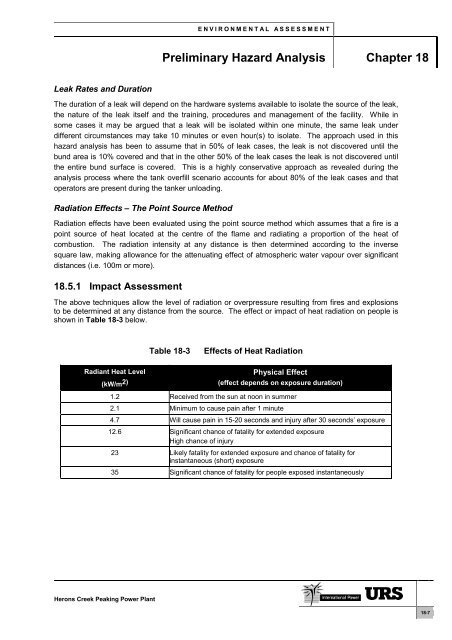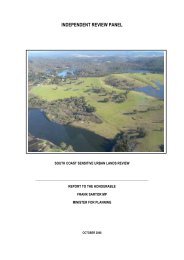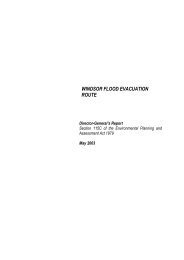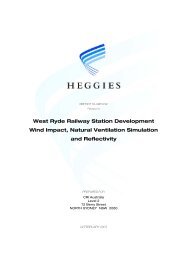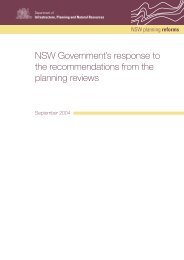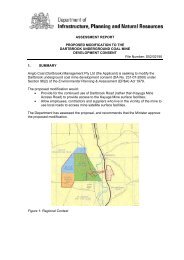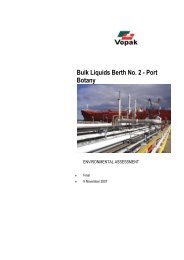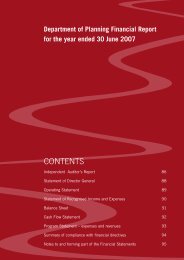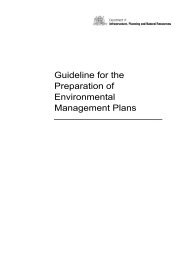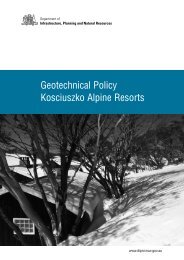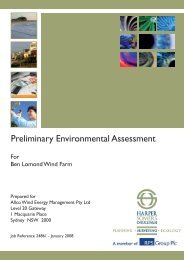Preliminary Hazard Analysis - Department of Planning
Preliminary Hazard Analysis - Department of Planning
Preliminary Hazard Analysis - Department of Planning
You also want an ePaper? Increase the reach of your titles
YUMPU automatically turns print PDFs into web optimized ePapers that Google loves.
E N V I R O N M E N T A L A S S E S S M E N T<br />
<strong>Preliminary</strong> <strong>Hazard</strong> <strong>Analysis</strong> Chapter 18<br />
Leak Rates and Duration<br />
The duration <strong>of</strong> a leak will depend on the hardware systems available to isolate the source <strong>of</strong> the leak,<br />
the nature <strong>of</strong> the leak itself and the training, procedures and management <strong>of</strong> the facility. While in<br />
some cases it may be argued that a leak will be isolated within one minute, the same leak under<br />
different circumstances may take 10 minutes or even hour(s) to isolate. The approach used in this<br />
hazard analysis has been to assume that in 50% <strong>of</strong> leak cases, the leak is not discovered until the<br />
bund area is 10% covered and that in the other 50% <strong>of</strong> the leak cases the leak is not discovered until<br />
the entire bund surface is covered. This is a highly conservative approach as revealed during the<br />
analysis process where the tank overfill scenario accounts for about 80% <strong>of</strong> the leak cases and that<br />
operators are present during the tanker unloading.<br />
Radiation Effects – The Point Source Method<br />
Radiation effects have been evaluated using the point source method which assumes that a fire is a<br />
point source <strong>of</strong> heat located at the centre <strong>of</strong> the flame and radiating a proportion <strong>of</strong> the heat <strong>of</strong><br />
combustion. The radiation intensity at any distance is then determined according to the inverse<br />
square law, making allowance for the attenuating effect <strong>of</strong> atmospheric water vapour over significant<br />
distances (i.e. 100m or more).<br />
18.5.1 Impact Assessment<br />
The above techniques allow the level <strong>of</strong> radiation or overpressure resulting from fires and explosions<br />
to be determined at any distance from the source. The effect or impact <strong>of</strong> heat radiation on people is<br />
shown in Table 18-3 below.<br />
Table 18-3<br />
Effects <strong>of</strong> Heat Radiation<br />
Radiant Heat Level<br />
(kW/m 2)<br />
Physical Effect<br />
(effect depends on exposure duration)<br />
1.2 Received from the sun at noon in summer<br />
2.1 Minimum to cause pain after 1 minute<br />
4.7 Will cause pain in 15-20 seconds and injury after 30 seconds’ exposure<br />
12.6 Significant chance <strong>of</strong> fatality for extended exposure<br />
High chance <strong>of</strong> injury<br />
23 Likely fatality for extended exposure and chance <strong>of</strong> fatality for<br />
instantaneous (short) exposure<br />
35 Significant chance <strong>of</strong> fatality for people exposed instantaneously<br />
Herons Creek Peaking Power Plant<br />
18-7


